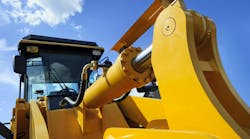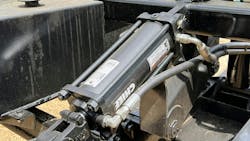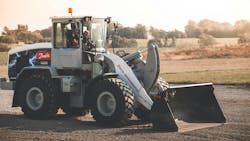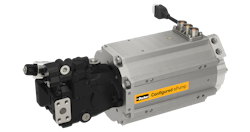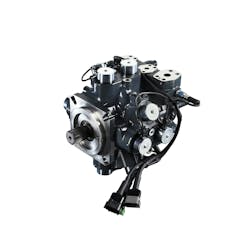Mobile equipment such as construction and agricultural machinery rely heavily on hydraulics for a variety of machine functions, such as lifting the boom of an excavator.
The requirements placed on hydraulic systems used in these machines continue to evolve, with greater efficiency and connectivity being some of the current technological drivers. In addition, the larger industry trends of electrification, automation and digitalization continue to influence hydraulic system designs.
Power & Motion spoke with members of the fluid power industry to get their perspectives on the technologies and trends currently influencing mobile hydraulics as well as what technological developments may yet lie ahead.
*Editor's Note: Questions and responses have been edited for clarity.
Power & Motion (P&M): What industry trends (such as automation, digitalization, etc.) are currently making the biggest impact on hydraulic system designs for mobile applications?
Ken Baker, CEO of Bailey International: The biggest trends in hydraulic component design are digitization and efficiency. Efficiency is getting significant focus as our customers look for ways to reduce energy usage. This is reflected in component weight and size, or both, along with varied materials that may be used to accomplish the same goal.
Digitization is also significant. This includes the engineering of sensors either into our products or as easy-to-use add-ons to the system. It also includes the increased use of control elements, like electronic controllers and electro-hydraulic valves, in the system’s design. Bailey has worked hard to increase our product offerings in this area, and we have worked hard to increase our technical expertise to better serve our customers.
Jeff Herrin, Senior Vice President, Research & Development, Danfoss Power Solutions: An ongoing trend we see in the mobile hydraulics industry is the continuous shift toward electronic controls. This relates to hydraulic system designs in that the hydraulic components are getting smarter. Many now have onboard computers that allow us to control not only the components, but also lift it to the system level, where the entire system is being designed with the understanding that the electronic control overrides the hydraulics and really creates value for the customer. An example of this is automation and autonomy, also an industry trend. Electronics and software are essential to enabling these modern control systems. Globally, a lack of labor or skilled laborers is driving the industry toward more automation and more intelligence on machines.
The other industry trend shaping hydraulic system designs is environmental stewardship. Worldwide, we’re seeing a lot more focus on the environmental impact of a machine throughout its lifecycle. Emerging legislation will continue to challenge not only OEMs, but also suppliers to create more efficient and more recyclable hydraulic solutions. This is a trend that we'll be talking about for another 25 years, but it's much earlier in terms of its impact on shifting thinking and buying behaviors. It's no doubt here, and it will start to shape hydraulic systems in the direction of more efficient solutions as we go forward.
Christopher Griffin, Business Development Manager - Electrification, Motion Systems Group, Parker Hannifin Corp.: Certainly, electrification is driving changes to hydraulic system design, both in terms of maximizing efficiency and also in designing for the power-on-demand capability that an electrified hydraulic system can provide. Digitalization, as it impacts hydraulic system components, can provide a higher level of controllability, provide valuable system diagnostics, and also enable greater levels of autonomous control.
READ MORE: The 5 Levels of Autonomy in Off-Highway Equipment
P&M: How, if at all, are you seeing changes being made to hydraulic system architectures and what is driving these changes?
Jeff Herrin, Danfoss: The need for greater machine intelligence and automation means the control system over the hydraulics is almost always driven by software, and it's always driven between components and systems by the fundamental elements of how that machine operates. We’re seeing controls on machines moving more to components and away from conventional centralized control because you have more variables in play and therefore greater flexibility to optimize machine performance. From an intelligent system perspective, if you have five components and five computers, you can truly look at the sweet spot at every operating condition, and you can do it on the fly. You don't have to preprogram it because modern AI (artificial intelligence) technology and machine learning allows us to optimize without even having to think about it. In terms of the core value proposition, this brings greater productivity, greater safety, and potentially much higher operating efficiencies for components that are really the same components we had 20 years ago. Electronic controls are bringing us to a whole new level of system performance.
Along the same vein but more at the component design level, we're seeing a lot more variable components instead of fixed components, meaning the components are adjustable dynamically in the machine. And that's related to this idea that we want to fully optimize a system by having as many variables as possible.
Christopher Griffin, Parker Hannifin: In the case of electrification, we are seeing a focus on overall system efficiency to maximize battery capacity in battery-powered equipment. A lot of early machine designs sought to minimize changes to the hydraulic system already in use with ICE (internal combustion engine)-driven equipment, but the cost of batteries are such a major factor in the ultimate cost of a battery-powered machine that any incremental efficiency improvements have an effect.
P&M: What are some of the biggest challenges you see facing the hydraulics industry – either from a design or end use customer perspective, or both?
Ken Baker, Bailey: With the move to digitization and sensor inclusion, the need for a mix of mechanical and electronic knowledge is crucial. Also, the need for more advanced programming capability is important to support our customers.
We see more customers relying on us (and others like Bailey) to supply the engineering and technical expertise for their designs.
READ MORE: Understanding Digitalization and its Use in Fluid Power
P&M: How much is electrification impacting your hydraulic component and/or system developments?
Ken Baker, Bailey: We are seeing the start of a change to electrical prime movers in mobile systems. This might be in the form of electric direct-drive systems or in ePTO types of usage. In the mid-market customer space, which we serve, this is still in its infancy. It is still discussions-only at this stage.
Jeff Herrin, Danfoss: We’re seeing a rapidly increasing number of customer inquiries for hydraulic system optimization in hybrid and fully electric vehicles, either battery or hydrogen driven. The first wave of electrification was purely at the rotary actuator level, with an electric motor replacing a hydraulic motor in a propel application. But OEMs had little bandwidth to fully optimize the machine around this change. We’re now seeing the second wave of electrification, where a lot of those early adopters are focusing on optimizing the hydraulics. Danfoss is fielding a lot of interest and we’re working on more energy-optimized solutions as well as the interface between electrics and hydraulics at a component level so that we can develop integrated packages and provide more cost-efficient solutions. Customer inquiries are coming at a higher pace than they were even a year ago. It’s early in terms of visibility — we won't see many of these developments in commercial production for a few years — but at the working level, hydraulic optimization for electric machines is becoming a very common, everyday topic within our customer base.
Christopher Griffin, Parker Hannifin: Electrification creates both opportunities and challenges with respect to hydraulic system design. The on-demand power, as well as the dynamic torque and speed control that permanent-magnet motor technologies bring, creates opportunities to simplify the hydraulic system and improve performance. The challenge comes with the relative inefficiency of hydraulic systems that reduces the operating range of the battery system in a full-electric machine.
The other challenge is noise. In a typical ICE-driven machine, the engine noise tended to drown out any other noises that the hydraulic system generated. Once the engine is removed, system designers need to think about pump technology and operating speed, for example, as major contributors to noise that need to be managed. It’s different with every machine, every operator and every operating environment, so there’s no easy answer.
P&M: Are you seeing electric alternatives replacing hydraulics in mobile applications? If yes, in what ways or applications are hydraulics being replaced?
Ken Baker, Bailey: We are not seeing direct replacement of hydraulics with electrical solutions, nor do I see this happening. The energy density and force generation of hydraulics is so much greater than what electric solutions can handle that I believe this change will remain limited to small, lower force applications.
Jeff Herrin, Danfoss: Electrics are replacing hydraulics in some applications, primarily rotary applications such as wheel drives, cutter drives on turf care machines, and the like. Electrics make sense here because there’s a need for good controllability and high speed. We also see electrics in small- to medium-sized construction machinery. Electrified propel systems in wheel loaders is one example that is already commercially available. Very high-power applications are still a challenge for electric alternatives. We have high-voltage solutions for excavator track and slew drives, but not yet on a big scale. It's technically possible, but we need to keep pushing the commercialization of those to bridge the power gap between low voltage and high voltage.
Christopher Griffin, Parker Hannifin: There are electric (or electromechanical) solutions to many applications that we currently solve with hydraulics, but there are pros and cons. All-electric systems are more efficient, quieter and often can control motion to a higher level of precision. They also require little or no maintenance. That said, all-electric motion solutions, both linear or rotary, are generally more costly, especially as force and power requirements increase, and they get heavier. All-electric systems are also less forgiving of shock, vibration, dirt and moisture in the operating environment. We are seeing some early work with all-electric motion on smaller machines, or on applications that are remote or far from the central power source. There will be some natural fit applications for all-electric motion, especially as costs mature and the ruggedness problem is addressed, but I don’t foresee a wholesale replacement of hydraulics across the mobile machinery market any time soon.
P&M: Do you foresee a time where hydraulics will become obsolete in mobile applications?
Jeff Herrin, Danfoss: The short answer is no. In certain use cases, electrics will replace hydraulics, primarily in rotary applications starting with low power and working its way up the power spectrum over time. The rotary technology transition is not a case of if, it’s a case of when. Conversely, it's going to be more challenging to find cost efficient, robust, and package-size capable electrified solutions to replace linear hydraulic power.
The other side of the equation is that hydraulics is still winning new applications from mechanical solutions on traditional machines. A good example is forklifts. We’ve had electrified forklifts for many years, but there’s also a huge volume of ICE forklifts that have mechanical or hydraulic drives. We're seeing more and more inquiries for hydraulic drives in applications that have been mechanically driven for almost 100 years.
So there’s this give and take happening. On one side hydraulics and electrics are competing for share, and on the other side hydraulics and mechanics are competing. It'll be that way for many decades to come, and I think anybody in the industry today should not worry. If you can find the right solution for the problem, you'll be in good shape.
READ MORE: Positive Outlook for Fluid Power Despite Electronics Making Inroads
P&M: What further technological development opportunities do you see in the future for hydraulic systems used in mobile applications?
Ken Baker, Bailey: Wireless solutions will continue to evolve. For both intra-machine connectivity and extra-machine controls, we are seeing increased requests for technical solutions.
As mobile machines gain more sensors and intelligence, improvement in local maintenance will continue to increase. There will be a role for deterministic and AI-based solutions in this space.
Jeff Herrin, Danfoss: At the component level, the development opportunity is in pumps and motors with significantly higher operating speeds and efficiency while maintaining power density. We need to make these components more comparable and capable in terms of what electric solutions can offer without compromising the strength of hydraulics. You can't build good hydraulic systems without good hydraulic components, and our components need to evolve to provide the right solutions for the systems of the future, whether they're hydraulic, electrohydraulic, or electric motor-driven hydraulic. There's a lot of scenarios and technologies that can be developed to support these systems, some incremental and some more disruptive, and companies in this space need to be thinking about and actively working on solutions.
With systems getting smarter, the other development opportunity is the control of off-highway machines. In fact, this is currently the highest priority for our technology investments at Danfoss. We’re doing a lot of work around automation and autonomy, ease of implementation and maintenance of control systems, and bringing in the data component of telematics for failure prevention and diagnostics. Making machines more intelligent starts with making components more intelligent, and that's a design and technology trend that is already prevalent and will continue. Where we’ll see developments is in the commercialization of machine learning, so artificial intelligence on these machines. This doesn’t necessarily mean full autonomy or driverless machines. Lower levels of automation are just as valuable, and machine learning algorithms with smart components and well-defined use cases are going to bring us a long way forward. At Danfoss we are investing considerably in software, in electronics, and in systems engineers to be at the forefront of control systems — you have to if you're going to be a player in the future of mobile machinery.
Christopher Griffin, Parker Hannifin: I see hydraulic systems continuing to become smarter and more connected, and not only in combination with electrification. Software capabilities will become as important as pressure and flow, and will enable higher levels of autonomy and augmented control of mobile machines. The greater level of connectivity will also allow owners to better manage their equipment through predictive maintenance and machine performance monitoring.
